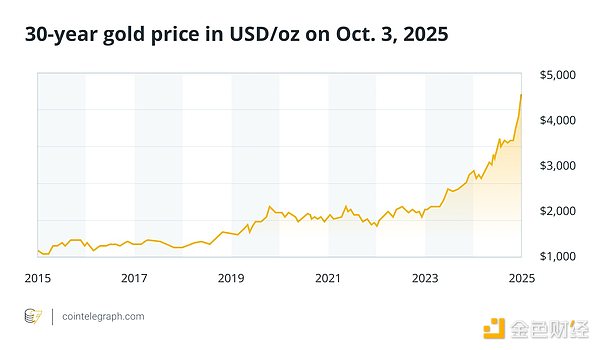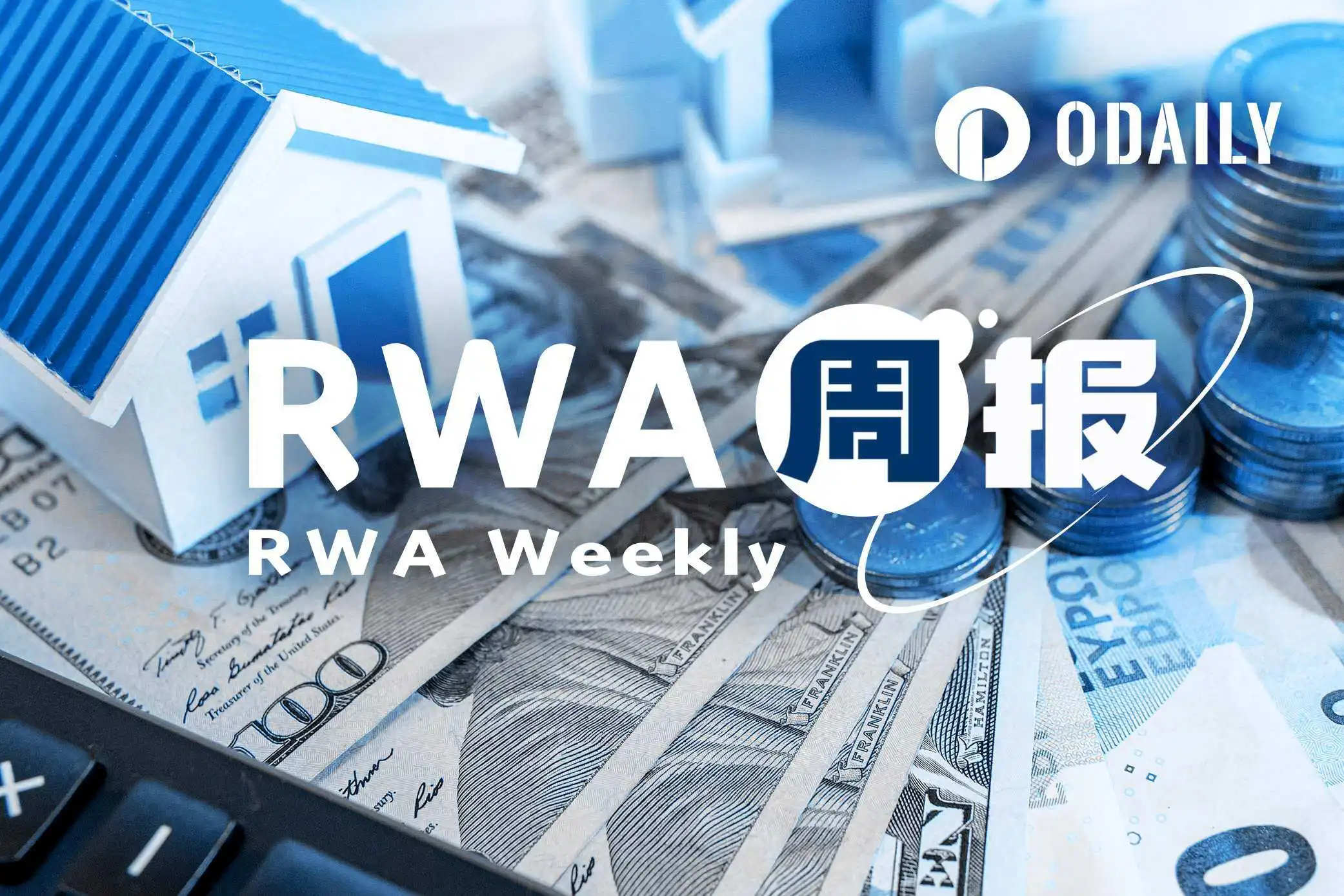Written by: Dilip Kumar Patairya, Cointelegraph
Translated by: Shaw Golden Finance
1. How the Gold Rush of October 2025 Ended
Driven by strong safe-haven demand, gold prices surged significantly, breaking through $4,300 per ounce and setting a new historical high. By October 2025, the market began to see profit-taking.
On October 17, 2025, after reaching this milestone, gold prices immediately fell by more than 2%. As of the time of writing, the spot gold price was approximately $4,023 per ounce, down 8.1% from the historical high of $4,378.69.
The main catalyst for this decline was a de-escalation in U.S.-China trade tensions after President Trump stated that comprehensive tariffs on China were unsustainable. Additionally, a stronger dollar and renewed investor interest in high-yield assets like Bitcoin contributed to this pullback.
2. The History of Gold: Crashes and Peaks
Gold prices have a history filled with dramatic rises and falls influenced by inflation, interest rates, and geopolitical events. From the peak in the early 1980s to the significant pullback after 2013, followed by a strong rebound in the 2020s, the gold market has experienced several fluctuations.
1980-1999: Driven by high inflation and geopolitical tensions, gold prices skyrocketed, peaking at around $850 per ounce in January 1980. Subsequently, then-Federal Reserve Chairman Paul Volcker raised interest rates significantly, triggering the "Volcker Shock," which ended the gold rally. Between 1980 and 1982, the Federal Reserve pushed the federal funds rate above 20% to curb inflation, leading to a severe economic recession. This triggered massive sell-offs, and by 1982, gold prices had fallen over 60%, entering a long-term bear market. Gold prices dropped from about $850 per ounce in 1980 to around $278 per ounce in 1999.
2012-2018: After peaking in 2011, gold prices began a long-term decline as global economic stability and strong stock market performance diminished gold's investment appeal. In 2013, the Federal Reserve began tapering its quantitative easing program, the dollar strengthened, and funds shifted to higher-yielding assets, further pressuring gold prices. The holdings of the major gold-backed exchange-traded fund (ETF), SPDR Gold Trust, decreased by over 30%, indicating waning investor interest. Between 2014 and 2018, gold prices fluctuated between $1,200 and $1,400 per ounce, well below the 2012 level of about $1,680.
2020s: In the uncertain global environment of the 2020s, gold regained its status as a safe-haven asset. The COVID-19 pandemic led to economic stagnation, and governments rolled out over $10 trillion in stimulus packages, raising concerns about inflation. By 2022, U.S. inflation had climbed above 9%, solidifying gold's position as a financial safeguard. Central banks also increased their gold purchases, adding about 1,000 tons of gold annually from 2022 to 2024. Even with rising interest rates, gold prices rose from over $1,785 in 2020 to above $3,200 in early 2025.
However, the decline in gold prices in October 2025 prompted investors to seek alternatives like Bitcoin, which is relatively unaffected by government and central bank policies.

3. How Funds Began Flowing into Bitcoin
The notion of Bitcoin as "digital gold" is gaining traction, with younger investors increasingly viewing Bitcoin as a modern means to hedge against inflation and currency devaluation. Many believe Bitcoin is more accessible and innovative than physical gold, causing its market capitalization to soar from $134 billion in 2019 to over $2.4 trillion in the first half of 2025.
Spot Bitcoin ETFs and exchange-traded products (ETPs) have provided institutional investors with professional-grade investment channels, attracting billions of dollars in compliant capital. In early October 2025, U.S. spot Bitcoin ETFs recorded a weekly inflow of $3.55 billion, with BlackRock's iShares Bitcoin Trust (IBIT) performing exceptionally well, helping Bitcoin prices surpass $126,000. Meanwhile, gold ETFs saw outflows exceeding $2.8 billion in recent weeks, contrasting sharply with Bitcoin's strong momentum.
Historically, outflows from gold have been inversely related to inflows into Bitcoin, with the correlation between Bitcoin and gold dropping to -0.3 during periods of heightened risk appetite. Exchange balances have fallen to a six-year low of 2.83 million Bitcoins, indicating reduced selling pressure.
4. Is a $200,000 Bitcoin Target Realistic?
The path for Bitcoin to reach $200,000 appears supported by strong market and macroeconomic factors. The halving in April 2024 reduced block rewards, tightening supply amid growing demand. Multiple indicators continue to suggest that Bitcoin will grow steadily.
As global debt continues to rise, Bitcoin's appeal as a decentralized investment asset is increasing. By the first half of 2025, global debt had reached nearly $338 trillion, about 235% of global GDP.
Institutional catalysts driving Bitcoin's adoption are continuously strengthening. As of October 24, 2025, MicroStrategy (MSTR) held 640,418 Bitcoins, followed by Marathon Digital Holdings (MARA) and Celsius (CEP), which held 53,250 and 43,514 Bitcoins, respectively.
The Federal Reserve's easing of monetary policy could provide additional boosts. The $200,000 level serves as a strong psychological benchmark that may prompt investors to withdraw funds from assets like gold, from which $2.8 billion has already flowed out of gold ETFs.
5. How Funds Shift from Gold to Bitcoin
The shift of funds from gold to Bitcoin often defines major market cycles, highlighting how investor preferences evolve over time. Key cycles include:
2013-2017: From 2013 to 2017, gold prices remained largely between $1,200 and $1,400 per ounce after peaking in 2011, while Bitcoin soared from $100 to $20,000. This surge was driven by retail investors seeking a decentralized currency alternative.
2020-2021: From 2020 to 2021, institutional adoption propelled Bitcoin prices to $69,000, as pandemic-era stimulus measures and inflation concerns led companies like MicroStrategy to favor Bitcoin over gold. Historically, gold attracts cautious investors during stable periods, but during risk-on phases, Bitcoin often draws funds due to its scarcity and growth potential.
Recent trends have reinforced this shift. In October 2025, Bitcoin ETFs recorded a weekly inflow of $3.55 billion, while gold ETFs experienced outflows of $2.8 billion. These fund flows highlight that, amid ongoing global uncertainty, investors are transitioning towards digital assets.
6. Obstacles to Bitcoin Reaching $200,000
While cryptocurrency enthusiasts anticipate Bitcoin reaching $200,000, the path is not without challenges. Obstacles include price volatility, regulatory uncertainty, the potential for a gold recovery, and competition from other assets:
Bitcoin's Volatility: Like all cryptocurrencies, Bitcoin is highly volatile, experiencing dramatic rises and falls. Institutional buying can trigger price increases, while sell-offs by large holders ("whales") can lead to sudden price drops.
Regulatory Uncertainty: In many regions worldwide, Bitcoin regulation is still evolving. Ongoing ambiguities regarding taxation and compliance may hinder institutional participation.
Potential Recovery of Gold: In October 2025, some investors who had reaped substantial returns began withdrawing from gold mining ETFs. Meanwhile, Reuters reported that in the third week of October 2025, global cryptocurrency ETF inflows reached a record $5.95 billion. Strong demand for cryptocurrency assets propelled Bitcoin to new historical highs. However, as a safe-haven asset, gold may still have the potential for a comeback.
Competition from Other Assets: Stocks have an average annual return of about 10%, competing with digital assets. Tokenized government bonds and central bank digital currencies (CBDCs) also offer stable alternatives. These options may divert funds away from Bitcoin.
7. Generational Shift in Value Storage Assets
Generational change is redefining perceptions of value storage assets. Young investors, growing up in the digital age, increasingly favor Bitcoin due to its decentralized, borderless nature and potential for high returns.
In contrast, older investors still prefer gold for its physical form and proven stability. The growing trend of digitization in finance is accelerating this shift, with blockchain technology replacing slow paper systems with more transparent and efficient alternatives.
However, over time, gold and Bitcoin may coexist in a dual-hedging model. Gold offers reliability through its physical scarcity and historical record, while Bitcoin provides growth through its limited supply and digital adaptability. Together, they strike a balance between tradition and innovation, reflecting how investors adapt to an increasingly complex financial world.
免责声明:本文章仅代表作者个人观点,不代表本平台的立场和观点。本文章仅供信息分享,不构成对任何人的任何投资建议。用户与作者之间的任何争议,与本平台无关。如网页中刊载的文章或图片涉及侵权,请提供相关的权利证明和身份证明发送邮件到support@aicoin.com,本平台相关工作人员将会进行核查。




